
Demystifying the Electronic Credit Reversal and Reclaimed Statement: A Guide for GST Compliance
The Goods and Services Tax Network (GSTN) has unveiled a novel addition to its arsenal of digital tools: the “Electronic Credit Reversal and Reclaimed Statement,” now prominently featured on the GST portal. This innovative ledger serves a crucial function, specifically dedicated to documenting the intricacies of Input Tax Credit (ITC) reversals within the GSTR-3B filing framework, under the purview of Table 4B(2).
The introduction of this ledger signifies a concerted effort by the GSTN to enhance transparency and streamline reporting mechanisms for taxpayers grappling with the complexities of ITC management. By providing a dedicated platform to track and monitor credit reversals, businesses can navigate the labyrinth of compliance obligations with greater ease and precision.
Delving deeper into the underlying provisions of the GST law, the emergence of this electronic ledger reflects a broader commitment to bolstering the efficiency and effectiveness of the GST regime. It represents a symbiotic fusion of technological innovation and regulatory compliance, aimed at empowering taxpayers with the tools and resources necessary to navigate the intricate web of tax regulations with confidence and clarity.
Understanding the Purpose
The primary aim of introducing the Electronic Credit Reversal and Reclaimed Statement is to maintain a record of the amount of ITC reversed by registered persons, which can be reclaimed in subsequent months. This ledger facilitates accurate tracking to ensure that taxpayers do not reclaim more ITC than they have reversed, thus promoting compliance with GST rules.
Relevant Provisions of GST Law
Under Section 16(2) of the CGST Act, 2017, registered persons can avail ITC only if they satisfy certain conditions. Additionally, Rule 37 of the CGST Rules, 2017 specifies conditions for availing ITC, including the furnishing of invoice details in GSTR-1 and reflection of ITC in GSTR-2B.
Advisory by GSTN and Circulars by CBIC
The GSTN introduced a facility in November 2020 to auto-populate system-computed details in GSTR-3B from GSTR-1 and eligible ITC balances from GSTR-2B. Circular no. 170/02/2022 by CBIC emphasized the necessity of reversals of ITC in Table 4B(1) and 4B(2) of GSTR-3B, with Table 4B(1) reversals being permanent and Table 4B(2) reversals being temporary.
Functioning of the Electronic Credit Reversal and Reclaimed Statement
- Reporting Opening Balance: Taxpayers must report the cumulative balance of ITC reversed in earlier months, reclaimable till GSTR-3B of July 2023, as an opening balance in the GST portal.
- Automatic Calculation: For subsequent months from August 2023, the portal will calculate the closing balance of ITC reversed eligible for reclamation based on inputs from GSTR-3B filings.
Time Limit and Amendment Opportunities
Taxpayers have until 30th November 2023 to declare their opening balance for ITC reversal. They can amend this balance in the GST portal until 31st December 2023, with three opportunities provided for corrections.
Filing Return and Exceeding Balance
If the amount of reclaimed ITC exceeds the balance reflecting in the statement, the system will issue a warning message. Taxpayers can proceed with filing, but there’s a possibility of a notice from the department to explain the difference.
The Electronic Credit Reversal and Reclaimed Statement simplifies the process of tracking reversed ITC eligible for reclamation, ensuring compliance with GST regulations. By accurately reporting and reconciling ITC reversals and reclaims, taxpayers can maintain transparency and accuracy in their GST filings, thus streamlining the compliance process.
Ready to navigate the complexities of GST with confidence?
Let’s unravel the mysteries together.
We are just a click away info@gstwala.comTop of Form
